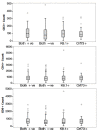Prevalence and predictors of kaposi sarcoma herpes virus seropositivity: a cross-sectional analysis of HIV-infected adults initiating ART in Johannesburg, South Africa
- PMID: 22093140
- PMCID: PMC3245423
- DOI: 10.1186/1750-9378-6-22
Prevalence and predictors of kaposi sarcoma herpes virus seropositivity: a cross-sectional analysis of HIV-infected adults initiating ART in Johannesburg, South Africa
Abstract
Background: Kaposi sarcoma (KS) is the most common AIDS-defining tumour in HIV-infected individuals in Africa. Kaposi sarcoma herpes virus (KSHV) infection precedes development of KS. KSHV co-infection may be associated with worse outcomes in HIV disease and elevated KSHV viral load may be an early marker for advanced HIV disease among untreated patients. We examined the prevalence of KSHV among adults initiating antiretroviral therapy (ART) and compared immunological, demographic and clinical factors between patients seropositive and seronegative for KSHV.
Results: We analyzed cross-sectional data collected from 404 HIV-infected treatment-naïve adults initiating ART at the Themba Lethu Clinic, Johannesburg, South Africa between November 2008 and March 2009. Subjects were screened at ART initiation for antibodies to KSHV lytic K8.1 and latent Orf73 antigens. Seropositivity to KSHV was defined as positive to either lytic KSHV K8.1 or latent KSHV Orf73 antibodies. KSHV viremia was determined by quantitative PCR and CD3, 4 and 8 lymphocyte counts were determined with flow cytometry. Of the 404 participants, 193 (48%) tested positive for KSHV at ART initiation; with 76 (39%) reactive to lytic K8.1, 35 (18%) to latent Orf73 and 82 (42%) to both. One individual presented with clinical KS at ART initiation. The KSHV infected group was similar to those without KSHV in terms of age, race, gender, ethnicity, smoking and alcohol use. KSHV infected individuals presented with slightly higher median CD3 (817 vs. 726 cells/mm3) and CD4 (90 vs. 80 cells/mm3) counts than KSHV negative subjects. We found no associations between KSHV seropositivity and body mass index, tuberculosis status, WHO stage, HIV RNA levels, full blood count or liver function tests at initiation. Those with detectable KSHV viremia (n = 19), however, appeared to present with signs of more advanced HIV disease including anemia and WHO stage 3 or 4 defining conditions compared to those in whom the virus was undetectable.
Conclusions: We demonstrate a high prevalence of KSHV among HIV-infected adults initiating ART in a large urban public-sector HIV clinic. KSHV viremia but not KSHV seropositivity may be associated with markers of advanced HIV disease.
Figures
Similar articles
-
Kaposi sarcoma-associated herpes virus and response to antiretroviral therapy: a prospective study of HIV-infected adults.J Acquir Immune Defic Syndr. 2013 Aug 1;63(4):442-8. doi: 10.1097/QAI.0b013e3182969cc1. J Acquir Immune Defic Syndr. 2013. PMID: 23614996 Free PMC article.
-
Kaposi sarcoma-associated herpesvirus, HIV-1 and Kaposi sarcoma risk in black South Africans diagnosed with cancer during antiretroviral treatment rollout.Int J Cancer. 2023 May 15;152(10):2081-2089. doi: 10.1002/ijc.34454. Epub 2023 Feb 15. Int J Cancer. 2023. PMID: 36727526
-
Kaposi sarcoma herpes virus antibody response and viremia following highly active antiretroviral therapy in the Swiss HIV Cohort study.AIDS. 2010 Sep 10;24(14):2245-52. doi: 10.1097/QAD.0b013e32833b7830. AIDS. 2010. PMID: 20543658
-
Detection and quantification of Kaposi's sarcoma-associated herpesvirus to predict AIDS-associated Kaposi's sarcoma.AIDS. 2003 Aug 15;17(12):1847-51. doi: 10.1097/00002030-200308150-00015. AIDS. 2003. PMID: 12891072
-
Optimal time for initiation of antiretroviral therapy in asymptomatic, HIV-infected, treatment-naive adults.Cochrane Database Syst Rev. 2010 Mar 17;2010(3):CD008272. doi: 10.1002/14651858.CD008272.pub2. Cochrane Database Syst Rev. 2010. PMID: 20238364 Free PMC article. Review.
Cited by
-
Kaposi sarcoma-associated herpes virus and response to antiretroviral therapy: a prospective study of HIV-infected adults.J Acquir Immune Defic Syndr. 2013 Aug 1;63(4):442-8. doi: 10.1097/QAI.0b013e3182969cc1. J Acquir Immune Defic Syndr. 2013. PMID: 23614996 Free PMC article.
-
Recent advances in Kaposi sarcoma herpesvirus-associated multicentric Castleman disease.Curr Opin Oncol. 2012 Sep;24(5):495-505. doi: 10.1097/CCO.0b013e328355e0f3. Curr Opin Oncol. 2012. PMID: 22729151 Free PMC article. Review.
-
Kaposi's Sarcoma in HIV-infected patients in South Africa: Multicohort study in the antiretroviral therapy era.Int J Cancer. 2014 Dec 1;135(11):2644-52. doi: 10.1002/ijc.28894. Epub 2014 May 2. Int J Cancer. 2014. PMID: 24729433 Free PMC article.
-
HIV-associated Kaposi sarcoma and related diseases.AIDS. 2017 Sep 10;31(14):1903-1916. doi: 10.1097/QAD.0000000000001567. AIDS. 2017. PMID: 28609402 Free PMC article. Review.
-
HHV-8 seroprevalence in HIV-positive and HIV-negative populations.Int J Cancer. 2015 Mar 1;136(5):1243. doi: 10.1002/ijc.29183. Epub 2014 Sep 18. Int J Cancer. 2015. PMID: 25196841 Free PMC article. No abstract available.
References
-
- UNAIDS. 2008 report on the global AIDS epidemic. 2008. http://www.unaids.org/en/dataanalysis/epidemiology/2008reportontheglobal... Accessed August 2010.
Grants and funding
LinkOut - more resources
Full Text Sources
Research Materials


